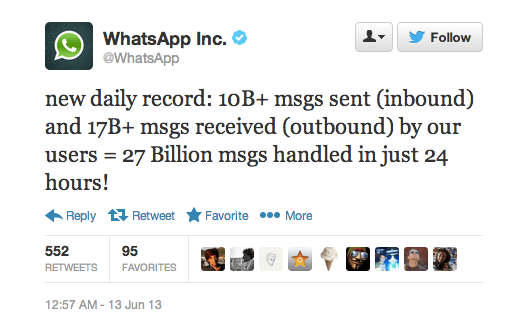Along with Skype, WhatsApp is the granddaddy of the mobile messaging app space. But despite its relative great age (~47 months), certainly compared to the myriad messaging newcomers, it appears to be continuing to build usage momentum. Earlier today WhatsApp announced a new daily messaging metric record, following on from its recent “bigger than Twitter” boast. Its new daily high is 10 billion+ inbound (sent) messages and 17 billion+ outbound (received) messages — making for a total of 27 billion+ processed missives in 24 hours.
The reason for the inbound/outbound discrepancy is down to WhatsApp’s group chat feature which means one sent message can be seen by multiple participants. Group chat in WhatsApp still refers to message-based comms since it doesn’t support VoIP calls (although it does offer the ability to send audio notes — so keeping true to its messaging ethos).
Back in April WhatsApp CEO Jan Koum told the AllThingsD Dive Into Mobile conference that the messaging app was seeing an average of 8 billion inbound, and 12 million outbound messages per day, so its new daily record is still within touching distance of those averages. Still, it does indicate WhatsApp is continuing to build momentum, despite all the additional (free) competition in the messaging app space. Most recently Facebook has stepped up its efforts, with the launch of its Home launcher for Android that adds a messaging layer called Chat Heads atop smartphone content in a bid to keep users chatting within Facebook, rather than using rivals’ messaging software. (Albeit, Home hasn’t got off to a great start.)
Other newer mobile messaging players, such as Line and WeChat, have focused on offering multimedia messaging options, with support for emoji/stickers and video, and in Line’s case additional games and apps featuring its kawaii characters. Line has also been building out its global presence, having pushed beyond its home market of Japan, and the Asian region in general, to target Europe via Spain and also the U.S. and Latin America.
The latest version of Line’s iOS app adds support for additional European languages (h/t to TNW for spotting): namely German, Italian and Portuguese, showing that it’s keeping up the pressure on WhatsApp in a region that’s traditionally been one of its strongholds. Back in March Line also added French and Brazilian Portuguese to support its push into Latin America. As well as going aggressively after a global user-base, Line continues to bolster its in-app functions. v3.7.0 of its iOS app adds an in-app browser, for instance, plus themes featuring its sticker characters; alerts for chats that failed to send; and a photos button in the chat room menu to view all sent/received shots from that chat.
WhatsApp has taken a different route to most of its messaging rivals by charging users for continued use of its service, with a $0.99 per year fee on most mobile platforms. Whereas Line, for instance, is monetising its service via in-app add-on content — such as paid stickers and gaming related downloads. In its Q1 earnings earlier this year, Line reported revenue of $58.9 million with game in-app purchases accounting for around half and paid stickers for around a third of that figure.
The freemium approach appears to be working well for Line, from a revenue generating point of view — WhatsApp’s revenues have been rumoured to be $100 million annually — but so far at least WhatsApp appears to be weathering the challenge posed by free-at-the-point-of-use competitors with no apparent signs of messaging momentum dropping off.
Most mobile messaging apps carry a natural lock-in since users typically require their friends to be using the same service in order to chat to them (Yuilop is an exception) so unless your friends decide en masse to move to a new service, you’re probably going to stick with what you’ve got. It remains to be seen whether WhatsApp rivals’ feature-focused innovations — pushing the envelope on multimedia comms and expanding entertainment-focused content — can start to lure significant numbers of its long-time users away.
